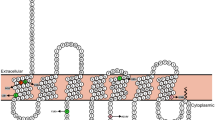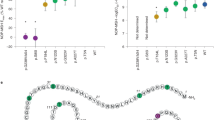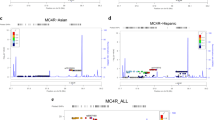Abstract
OBJECTIVE: To investigate whether genetic variation at the loci encoding the corticotropin-releasing factor receptors-1 and -2 (CRF-R1 and CRF-R2) contributes to human obesity.
DESIGN: The coding region of the CRF-R1 and CRF-R2 genes was screened in 51 severely obese children (body mass index (BMI)>4 kg/m2 standard deviations above the age-related mean) using denaturing high-performance liquid chromatography and direct nucleotide sequencing. Common polymorphisms that were identified were typed from a UK Caucasian population-based cohort by a PCR-based forced restriction digestion. A repeated measures analysis was used to determine associations between the C861T and G1047A genotypes and anthropometric and biochemical indices relevant to obesity.
RESULTS: In subjects with extreme early-onset obesity, four missense mutations were found, each in a single individual: CRF-R1 (Val161Met) and CRF-R2 (Glu220Asp, Val240Ile and Val411Met). However, none of these missense mutations clearly cosegregated with obesity in family studies. Two common single-nucleotide polymorphisms, C861T (Cys287Cys) in CRF-R1 and G1047A (Ser349Ser) in CRF-R2, were also detected. G1047A did not associate with any obesity-related phenotype. In contrast, carriers of the CRF-R1 polymorphism, C861T, had a significantly higher body mass index (BMI).
CONCLUSION: Mutations in the coding sequence of the CRF-R1 and CRF-R2 genes are unlikely to be a common monogenic cause of early-onset obesity. In an adult UK Caucasian population, the CRF-R1 C861T polymorphism is associated with increased BMI.
This is a preview of subscription content, access via your institution
Access options
Subscribe to this journal
Receive 12 print issues and online access
$259.00 per year
only $21.58 per issue
Buy this article
- Purchase on Springer Link
- Instant access to full article PDF
Prices may be subject to local taxes which are calculated during checkout

Similar content being viewed by others
References
Cone RD . The corticotropin-releasing hormone system and feeding behavior—a complex web begins to unravel. Endocrinology 2000; 141: 2713–2714.
Arase K, York DA, Shimizu H, Shargill N, Bray GA . Effects of corticotropin-releasing factor on food intake and brown adipose tissue thermogenesis in rats. Am J Physiol 1988; 255: E255–9.
Spina M, Merlo-Pich E, Chan RK, Basso AM, Rivier J, Vale W, Koob GF . Appetite-suppressing effects of urocortin, a CRF-related neuropeptide. Science 1996; 273: 1561–1564.
Krahn DD, Gosnell BA, Grace M, Levine AS . CRF antagonist partially reverses CRF- and stress-induced effects on feeding. Brain Res Bull 1986; 17: 285–289.
Gardner JD, Rothwell NJ, Luheshi GN . Leptin affects food intake via CRF-receptor-mediated pathways. Nat Neurosci 1998; 1: 103.
Vaughan J, Donaldson C, Bittencourt J, Perrin MH, Lewis K, Sutton S, Chan R, Turnbull AV, Lovejoy D, Rivier C, Rivier J, Sawchenko PE, Vale W . Urocortin, a mammalian neuropeptide related to fish urotensin I and to corticotropin-releasing factor. Nature 1995; 378: 287–292.
Smith GW, Aubry JM, Dellu F, Contarino A, Bilezikjian LM, Gold LH, Chen R, Marchuk Y, Hauser C, Bentley CA, Sawchenko PE, Koob GF, Vale W, Lee KF . Corticotropin releasing factor receptor 1-deficient mice display decreased anxiety, impaired stress response, and aberrant neuroendocrine development. Neuron 1998; 20: 1093–1102.
Timpl P, Spanagel R, Sillaber I, Kresse A, Reul JM, Stalla GK, Blanquet V, Steckler T, Holsboer F, Wurst W . Impaired stress response and reduced anxiety in mice lacking a functional corticotropin-releasing hormone receptor 1. Nat Genet 1998; 19: 162–166.
Bale TL, Contarino A, Smith GW, Chan R, Gold LH, Sawchenko PE, Koob GF, Vale WW, Lee KF . Mice deficient for corticotropin-releasing hormone receptor-2 display anxiety-like behaviour and are hypersensitive to stress. Nat Genet 2000; 24: 410–414.
Coste SC, Kesterson RA, Heldwein KA, Stevens SL, Heard AD, Hollis JH, Murray SE, Hill JK, Pantely GA, Hohimer AR, Hatton DC, Phillips TJ, Finn DA, Low MJ, Rittenberg MB, Stenzel P, Stenzel-Poore MP . Abnormal adaptations to stress and impaired cardiovascular function in mice lacking corticotropin-releasing hormone receptor-2. Nat Genet 2000; 24: 403–409.
Reyes TM, Lewis K, Perrin MH, Kunitake KS, Vaughan J, Arias CA, Hogenesch JB, Gulyas J, Rivier J, Vale WW, Sawchenko PE . Urocortin II: a member of the corticotropin-releasing factor (CRF) neuropeptide family that is selectively bound by type 2 CRF receptors. Proc Natl Acad Sci USA 2001; 98: 2843–2848.
Lewis K, Li C, Perrin MH, Blount A, Kunitake K, Donaldson C, Vaughan J, Reyes TM, Gulyas J, Fischer W, Bilezikjian L, Rivier J, Sawchenko PE, Vale WW . Identification of urocortin III, an additional member of the corticotropin-releasing factor (CRF) family with high affinity for the CRF2 receptor. Proc Natl Acad Sci USA 2001; 98: 7570–7575.
Hsu SY, Hsueh AJ . Human stresscopin and stresscopin-related peptide are selective ligands for the type 2 corticotropin-releasing hormone receptor. Nat Med 2001; 7: 605–611.
Nishiyama M, Makino S, Asaba K, Hashimoto K . Leptin effects on the expression of type-2 CRH receptor mRNA in the ventromedial hypothalamus in the rat. J Neuroendocrinol 1999; 11: 307–314.
Wu X, Cooper RS, Borecki I, Hanis C, Bray M, Lewis CE, Zhu X, Kan D, Luke A, Curb D . A combined analysis of genomewide linkage scans for body mass index from the National Heart, Lung, and Blood Institute Family Blood Pressure Program. Am J Hum Genet 2002; 70: 1247–1256.
Cole TJ . Conditional reference charts to assess weight gain in British infants. Arch Dis Child 1995; 73: 8–16.
Wareham NJ, Byrne CD, Williams R, Day NE, Hales CN . Fasting proinsulin concentrations predict the development of type 2 diabetes. Diabetes Care 1999; 22: 262–270.
Wille S, Sydow S, Palchaudhuri MR, Spiess J, Dautzenberg FM . Identification of amino acids in the N-terminal domain of corticotropin-releasing factor receptor 1 that are important determinants of high-affinity ligand binding. J Neurochem 1999; 72: 388–395.
Liaw CW, Grigoriadis DE, Lorang MT, De Souza EB, Maki RA . Localization of agonist- and antagonist-binding domains of human corticotropin-releasing factor receptors. Mol Endocrinol 1997; 11: 2048–2053.
Liaw CW, Grigoriadis DE, Lovenberg TW, De Souza EB, Maki RA . Localization of ligand-binding domains of human corticotropin-releasing factor receptor: a chimeric receptor approach. Mol Endocrinol 1997; 11: 980–985.
Xiong Y, Xie LY, Abou-Samra AB . Signaling properties of mouse and human corticotropin-releasing factor (CRF) receptors: decreased coupling efficiency of human type II CRF receptor. Endocrinology 1995; 136: 1828–1834.
Potter E, Sutton S, Donaldson C, Chen R, Perrin M, Lewis K, Sawchenko PE, Vale W . Distribution of corticotropin-releasing factor receptor mRNA expression in the rat brain and pituitary. Proc Natl Acad Sci USA 1994; 91: 8777–8781.
Cavagnini F, Croci M, Putignano P, Petroni ML, Invitti C . Glucocorticoids and neuroendocrine function. Int J Obes Relat Metab Disord 2000; 24 (Suppl 2): S77–S79.
Rubinstein M, Mortrud M, Liu B, Low MJ . Rat and mouse proopiomelanocortin gene sequences target tissue-specific expression to the pituitary gland but not to the hypothalamus of transgenic mice. Neuroendocrinology 1993; 58: 373–380.
Acknowledgements
This work was supported by the Wellcome Trust (NJW, ISF, SOR) and the MRC (SOR, NJW). We are grateful to all the physicians who have referred patients to the GOOS study, in particular, to Dr B Houston for help with clinical studies.
Author information
Authors and Affiliations
Corresponding author
Rights and permissions
About this article
Cite this article
Challis, B., Luan, J., Keogh, J. et al. Genetic variation in the corticotrophin-releasing factor receptors: identification of single-nucleotide polymorphisms and association studies with obesity in UK Caucasians. Int J Obes 28, 442–446 (2004). https://doi.org/10.1038/sj.ijo.0802564
Received:
Revised:
Accepted:
Published:
Issue Date:
DOI: https://doi.org/10.1038/sj.ijo.0802564
Keywords
This article is cited by
-
Is increased antidepressant exposure a contributory factor to the obesity pandemic?
Translational Psychiatry (2016)
-
Genetics of fat tissue accumulation in pigs: a comparative approach
Journal of Applied Genetics (2010)
-
The Human Obesity Gene Map: The 2005 Update
Obesity (2006)
-
The Human Obesity Gene Map: The 2004 Update
Obesity Research (2005)



